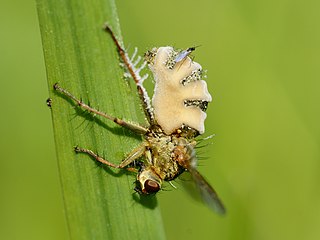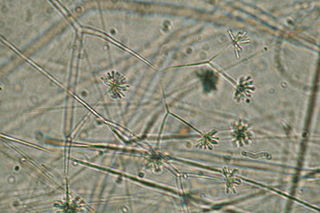
Zygomycota, or zygote fungi, is a former division or phylum of the kingdom Fungi. The members are now part of two phyla the Mucoromycota and Zoopagomycota. Approximately 1060 species are known. They are mostly terrestrial in habitat, living in soil or on decaying plant or animal material. Some are parasites of plants, insects, and small animals, while others form symbiotic relationships with plants. Zygomycete hyphae may be coenocytic, forming septa only where gametes are formed or to wall off dead hyphae. Zygomycota is no longer recognised as it was not believed to be truly monophyletic.

Pilobolus is a genus of fungi that commonly grows on herbivore dung.

Rhizopus is a genus of common saprophytic fungi on plants and specialized parasites on animals. They are found in a wide variety of organic substances , including "mature fruits and vegetables", jellies, syrups, leather, bread, peanuts, and tobacco. They are multicellular. Some Rhizopus species are opportunistic agents of human zygomycosis and can be fatal. Rhizopus infections may also be a complication of diabetic ketoacidosis. This widespread genus includes at least eight species.

The Mucorales is the largest and best studied order of zygomycete fungi. Members of this order are sometimes called pin molds. The term mucormycosis is now preferred for infections caused by molds belonging to the order Mucorales.

Mucor is a microbial genus of approximately 40 species of moulds commonly found in soil, digestive systems, plant surfaces, some cheeses like tomme de savoie, rotten vegetable matter and iron oxide residue in the biosorption process.

The Entomophthorales are an order of fungi that were previously classified in the class Zygomycetes. A new subdivision, Entomophthoromycotina, has recently been circumscribed for them.

The Cunninghamellaceae are a family of fungi in the order Mucorales.

The Pilobolaceae are a family of fungi in the Mucorales order. Generally, species in this family have a widespread distribution, although there are some that are restricted to tropical and subtropical regions. This family includes two genera: Pilobolus, and Utharomyces.

The Zoopagomycotina are a subdivision of the fungal division Zygomycota sensu lato. It contains 5 families and 20 genera. Relationships among and within subphyla of Zygomycota are poorly understood, and their monophyly remains in question, so they are sometimes referred to by the informal name zygomycetes.
The Zoopagales is an order of fungi in the subdivision Zoopagomycotina. Most species are parasites or predators of microscopic animals such as amoebae. They also prey on rotifers. The order contains 5 families, 22 genera, and 190 species.

Mucoromycotina is a subphylum of uncertain placement in Fungi. It was considered part of the phylum Zygomycota, but recent phylogenetic studies have shown that it was polyphyletic and thus split into several groups, it is now thought to be a paraphyletic grouping. Mucoromycotina is currently composed of 3 orders, 61 genera, and 325 species. Some common characteristics seen throughout the species include: development of coenocytic mycelium, saprotrophic lifestyles, and filamentous.
Dimargaritales is a monotypic order of fungi in the subdivision Kickxellomycotina.

The Basidiobolaceae are a family of fungi in the order Entomophthorales. All fungal cells of this family are exclusively uninucleate and their relatively large nuclei contain a nucleolus, but no heterochromatin.

The Mortierellaceae are a family of fungi in the order Mortierellales. The family contains six genera and 93 species.
The Zoopagaceae are a family of fungi in the Zoopagales order. The family contain contains 5 genera, and 67 species. The family was circumscribed in 1938.

The Piptocephalidaceae are a family of fungi in the Zoopagales order. The family contain contains 3 genera, and 70 species.

The Helicocephalidaceae are a family of fungi in the Zoopagales order. The family contain contains 3 genera and 12 species.
Echinochlamydosporium is a fungal genus in the Mortierellaceae family of the Zygomycota. The genus is monotypic, containing the single species Echinochlamydosporium variabile, found in China. The fungus grows on juvenile individuals of the soybean cyst nematode.

Zoophagus is a genus of zygomycete fungi that preys on rotifers and nematodes. It was established in 1911 by Sommerstorff, who originally considered it to be an oomycete. It is common in a variety of freshwater habitats, such as ponds and sewage treatment plants.
Stylopage is a polytypic genus of predacious fungus in the order Zoopagales, within the subphylum Zoopagomycotina. All known species of Stylopage subsist on various species of amoebae or nematodes by trapping their prey, typically using an adhesive substance that coats their vegetative hyphae, and absorbing nutrients through the projection of a haustorium. 17 extant Stylopage species have been described thus far.














